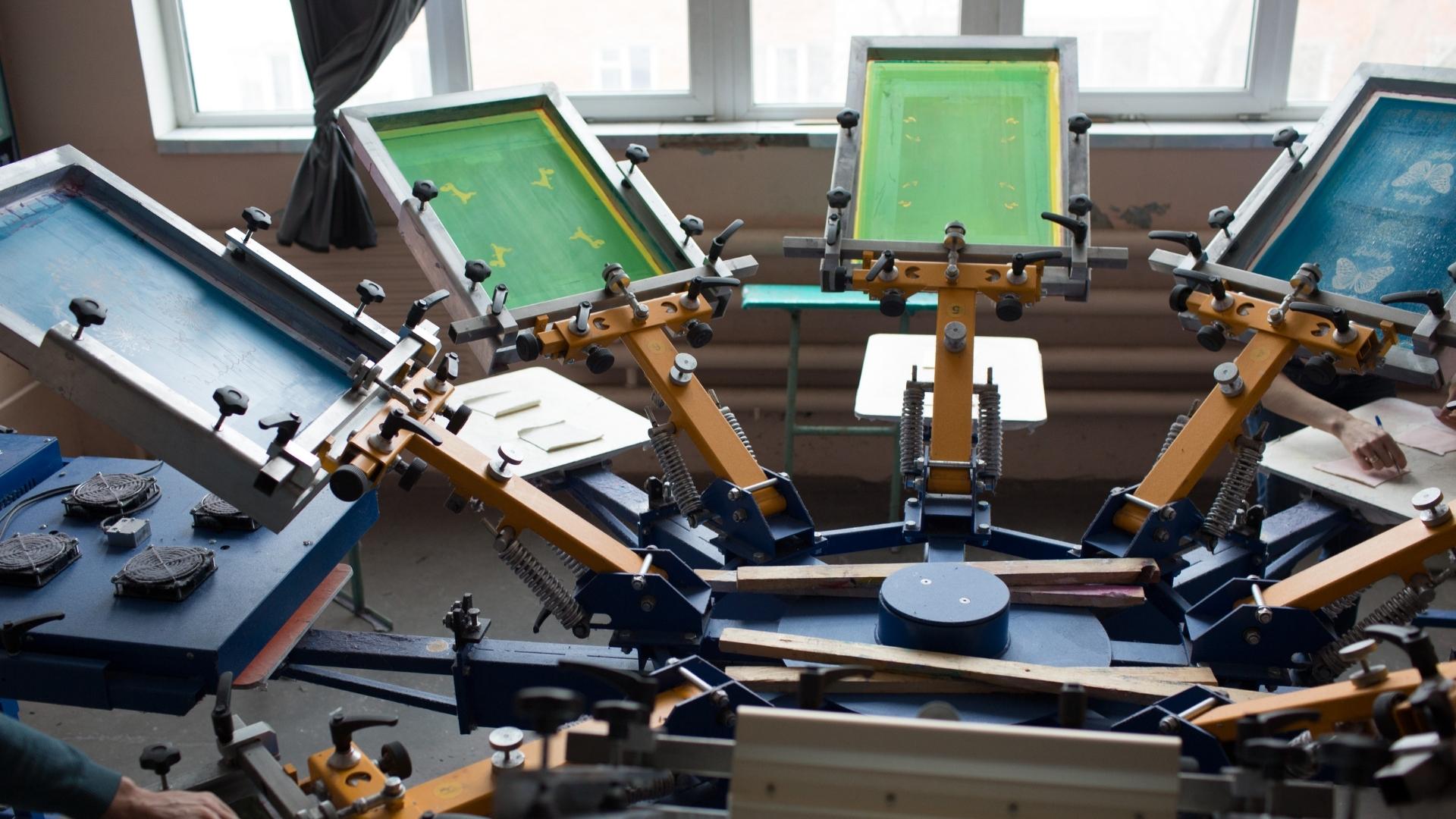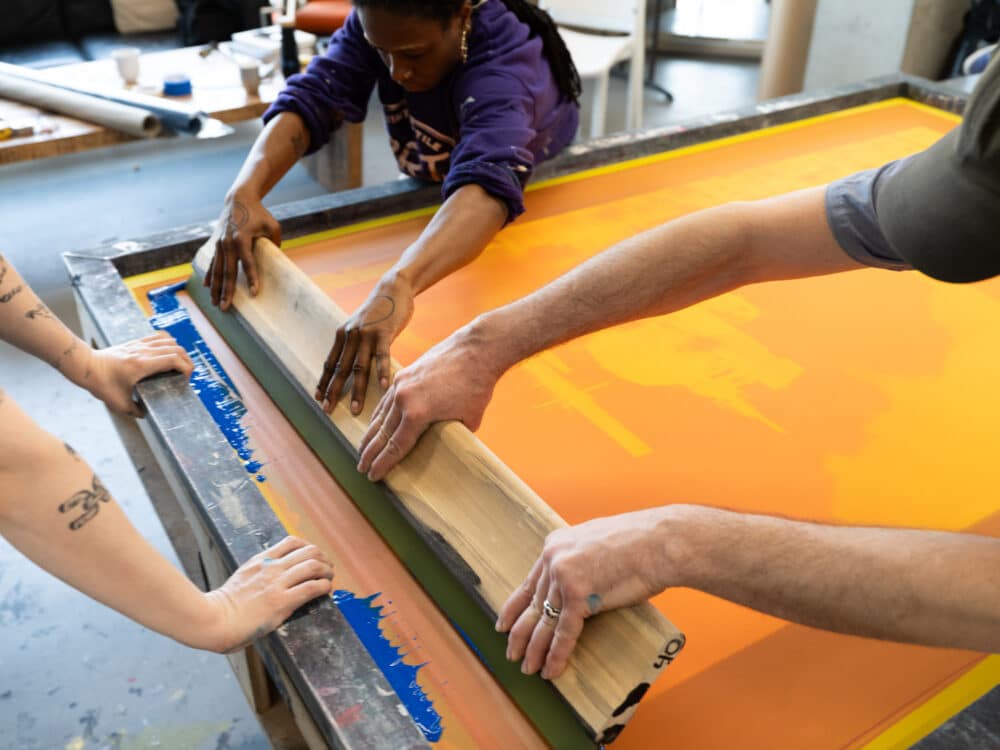Discover the Various Types of Screen Printing Techniques for Your Next Task
Screen printing offers a varied variety of techniques that can enhance any kind of creative project. From standard techniques like serigraphy to contemporary technologies such as direct-to-garment printing, each strategy has its one-of-a-kind advantages. Specialized choices, consisting of environmentally friendly and metal inks, introduce a lot more possibilities. Recognizing these methods can significantly affect the last outcome. Nevertheless, the difficulty exists in choosing one of the most ideal method for particular requirements and wanted results. What elements should one think about?

The Basics of Screen Printing
Although screen printing may seem complicated, it is basically a straightforward process that entails moving ink with a mesh screen onto different surfaces. The strategy begins with the creation of a pattern, which defines the design to be printed. This pattern is connected to a mesh screen, typically made of polyester or nylon. When the pattern remains in location, ink is put on the screen and pressed with the mesh making use of a squeegee, causing the desired pattern being published on the underlying material.
Screen printing can be performed on a large variety of substrates, consisting of fabric, paper, and plastic, making it a versatile selection for numerous tasks. The process permits detailed layouts and vibrant shades, making it popular in markets such as art, fashion, and marketing. Understanding these fundamentals equips individuals with the fundamental expertise needed to explore even more advanced methods in screen printing.
Traditional Screen Printing Techniques
Traditional screen printing strategies have been utilized for centuries, preserving the workmanship and creativity of this approach. This strategy utilizes a mesh screen to move ink onto a substratum, such as material or paper, enabling lasting and vivid layouts. The process starts with creating a pattern, which obstructs certain locations of the screen to regulate where the ink will be applied.
One popular method is serigraphy, typically utilized for artistic prints and limited editions. An additional is using water-based inks, which are eco-friendly and give a soft feel on textiles - 10:9 Design Texas. In addition, conventional techniques can consist of manual printing, where craftsmens apply ink with a squeegee, making certain accuracy and interest to detail
These techniques stay valued in the sector for their tactile top quality and the unique textures they create, attracting both makers and customers that appreciate the heritage of screen printing.
Digital Screen Printing Innovations
As the demand for faster production and customization in the printing industry has surged, digital screen printing technologies have actually emerged as a game-changer. This technology mixes conventional screen printing methods with digital processes, enabling rapid prototyping and detailed designs that were previously tough to accomplish. One considerable improvement is the introduction of direct-to-garment (DTG) printing, which facilitates premium, full-color prints on different fabrics without the need for displays. In addition, developments in ink solutions have caused environment-friendly alternatives that maintain vibrant shades while minimizing environmental effect. The usage of automated systems additionally streamlines manufacturing, lowering labor prices and enhancing precision. These developments not only accommodate little batch orders and individualized designs however likewise enable for quicker turnaround times, making them ideal for services concentrated on conference consumer demands in a fast-paced market. Digital screen printing, subsequently, represents an essential advancement in the domain name of printing techniques.
Specialized Screen Printing Approaches
Checking out specialized screen printing approaches discloses a varied range of methods that push the borders of creative thinking and functionality in the printing industry. Among these, glow-in-the-dark inks give an unique aesthetic effect, making designs come active in low-light problems. Metallic inks, recognized for their glittering finish, include a touch of deluxe to published materials. An additional ingenious method is discharge printing, which gets rid of dye from the textile rather of adding ink, causing a soft, vintage feeling. High-density printing creates an elevated structure check here on the surface, improving tactile interaction. In addition, water-based inks are acquiring appeal for their lively colors and reduced environmental effect. Each of these specialized methods satisfies details style requirements, making it possible for artists and brand names to produce standout products that resonate with their target markets. By leveraging these methods, businesses can boost their screen printing tasks to brand-new elevations, making sure unforgettable impressions.
Eco-Friendly Screen Printing Options
Green screen printing options are acquiring traction as the market changes towards sustainability. Lasting ink selections and using naturally degradable products are essential parts in lowering the ecological impact of the printing process. By embracing these practices, screen printers can add to a more lasting future while preserving top notch outcomes.
Lasting Ink Choices

Biodegradable Products Usage
As the screen printing market advances, the incorporation of eco-friendly materials is ending up being significantly vital for ecologically conscious practices. Manufacturers and developers are currently exploring inks and substratums made from natural, renewable energies that decompose extra effectively than traditional counterparts. These naturally degradable alternatives reduce plastic waste and reduce ecological effect, lining up with the expanding need for lasting items.
Usual instances consist of water-based inks and organic cotton fabrics, both of which reduce harmful chemicals and advertise eco-friendliness. Brand names that take on these products often boost their market allure, attracting consumers that prioritize sustainability. As understanding of environmental concerns remains to rise, the change towards biodegradable materials in screen printing is likely to gain energy, cultivating a greener industry standard.
Selecting the Right Strategy for Your Project
How can one figure out the most suitable screen printing technique for a particular project? The choice rests on numerous variables, including the material to be published on, the intricacy of the design, and the desired manufacturing volume - 10:9 Design LLC Company. Direct-to-garment printing is suitable for intricate styles with many shades, while traditional screen printing stands out for bigger runs of easier graphics.
Additionally, factor to consider of the end-use of the printed item is essential. For outdoor applications, strategies that supply resilience and weather resistance, such as plastisol ink, may be chosen. Alternatively, environmentally-conscious tasks might profit from naturally degradable products or water-based inks.
Eventually, understanding the project's distinct needs permits an educated selection, guaranteeing both visual charm and practical long life. By evaluating style intricacy, product compatibility, and manufacturing range, one can successfully select one of the most ideal screen printing method to fulfill their job's objectives.
Regularly Asked Inquiries
What Is the Background of Screen Printing?
Screen printing came from ancient China around 1000 ADVERTISEMENT, progressing with Japan and Europe. By the 20th century, it became popular in commercial art and style, revolutionizing just how designs were generated and dispersed around the world.

How Do I Prepare Artwork for Screen Printing?
To prepare artwork for screen printing, one should guarantee high resolution, use an appropriate color setting, produce separate layers for each and every shade, and transform text to details, guaranteeing compatibility with the printing procedure and desired end result.
What Products Are Finest for Screen Printing?
The most effective products for screen printing consist of premium inks, durable displays, and appropriate substratums like cotton, polyester, or blends. Furthermore, making use of ideal solution and squeegees can boost the printing procedure and results.
Can I Screen Print in the house?
Yes, screen printing in the house is possible. With the appropriate products, arrangement, and strategies, individuals can produce high-quality prints. Careful consideration of workspace and devices is necessary for successful results.
What Are Usual Blunders in Screen Printing?
Usual blunders in screen printing consist of inappropriate exposure times, insufficient ink consistency, imbalance of displays, inadequate cleaning of products, and neglecting to evaluate prints. These errors can compromise the top quality and precision of the last product.
Screen printing might seem complex, it is essentially a straightforward procedure that includes moving ink with a mesh screen onto numerous surfaces. As the need for faster manufacturing and personalization in the printing industry has actually risen, digital screen printing developments have arised as a game-changer. Discovering specialty screen printing techniques discloses a varied variety of strategies that press the boundaries of creativity and performance in the printing sector. The finest materials for screen printing include top quality inks, long lasting screens, and ideal substrates like cotton, polyester, or blends (10:9 Design reviews). Common blunders in screen printing consist of incorrect direct exposure times, poor ink consistency, misalignment of displays, not enough cleaning of materials, and disregarding to test prints